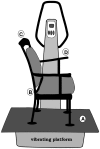Good vibrations--effects of whole body vibration on attention in healthy individuals and individuals with ADHD
- PMID: 24587412
- PMCID: PMC3938804
- DOI: 10.1371/journal.pone.0090747
Good vibrations--effects of whole body vibration on attention in healthy individuals and individuals with ADHD
Abstract
Objectives: Most of the current treatment strategies of ADHD are associated with a number of disadvantages which strengthen the need for alternative or additional approaches for the treatment of ADHD. In this respect, Whole Body Vibration (WBV) might be interesting as it was found to have beneficial effects on a variety of physiological measures. The present study explored the effects of WBV on attention of healthy individuals and adults diagnosed with ADHD.
Methods: Eighty-three healthy individuals and seventeen adults diagnosed with ADHD participated in the study. WBV treatment was applied passively, while participants were sitting on a chair which was mounted on a vibrating platform. A repeated measure design was employed in order to explore potential effects of WBV treatment on attention within subjects. Attention (i.e. inhibitory control) was measured with a color-word interference paradigm.
Results: A period of two minutes of WBV treatment had significant beneficial effects of small to medium size on attention of both healthy individuals and adults with ADHD. The effect of WBV treatment on attention did not differ significantly between groups.
Conclusions: WBV was demonstrated to improve cognitive performance of healthy individuals as well as of individuals with ADHD. WBV treatment is relatively inexpensive and easy to apply and might therefore be of potential relevance for clinical use. The application of WBV treatment as a cognitive enhancement strategy and as a potential treatment of cognitive impairments is discussed.
Conflict of interest statement
Figures



Similar articles
-
Acute Effects of Whole Body Vibration on Inhibition in Healthy Children.PLoS One. 2015 Nov 2;10(11):e0140665. doi: 10.1371/journal.pone.0140665. eCollection 2015. PLoS One. 2015. PMID: 26524188 Free PMC article.
-
Whole-body vibration improves cognitive functions of an adult with ADHD.Atten Defic Hyperact Disord. 2014 Sep;6(3):211-20. doi: 10.1007/s12402-014-0149-7. Epub 2014 Jul 17. Atten Defic Hyperact Disord. 2014. PMID: 25031090
-
Whole body vibration improves cognition in healthy young adults.PLoS One. 2014 Jun 20;9(6):e100506. doi: 10.1371/journal.pone.0100506. eCollection 2014. PLoS One. 2014. PMID: 24949870 Free PMC article. Clinical Trial.
-
The Clinical Utility of Whole Body Vibration: A Review of the Different Types and Dosing for Application in Metabolic Diseases.J Clin Med. 2024 Sep 5;13(17):5249. doi: 10.3390/jcm13175249. J Clin Med. 2024. PMID: 39274463 Free PMC article. Review.
-
The effects of whole-body vibration therapy on immune and brain functioning: current insights in the underlying cellular and molecular mechanisms.Front Neurol. 2024 Jul 31;15:1422152. doi: 10.3389/fneur.2024.1422152. eCollection 2024. Front Neurol. 2024. PMID: 39144715 Free PMC article. Review.
Cited by
-
Short-term effects of side-alternating Whole-Body Vibration on cognitive function of young adults.PLoS One. 2023 Jan 12;18(1):e0280063. doi: 10.1371/journal.pone.0280063. eCollection 2023. PLoS One. 2023. PMID: 36634088 Free PMC article.
-
Acute Effects of Whole Body Vibration on Inhibition in Healthy Children.PLoS One. 2015 Nov 2;10(11):e0140665. doi: 10.1371/journal.pone.0140665. eCollection 2015. PLoS One. 2015. PMID: 26524188 Free PMC article.
-
Measurement of the effect of physical exercise on the concentration of individuals with ADHD.PLoS One. 2015 Mar 24;10(3):e0122119. doi: 10.1371/journal.pone.0122119. eCollection 2015. PLoS One. 2015. PMID: 25803290 Free PMC article. Clinical Trial.
-
Vibration detection: its function and recent advances in medical applications.F1000Res. 2020 Jun 17;9:F1000 Faculty Rev-619. doi: 10.12688/f1000research.22649.1. eCollection 2020. F1000Res. 2020. PMID: 32595943 Free PMC article. Review.
-
Feasibility of Three Novel Forms of Passive Exercise in a Multisensory Environment in Vulnerable Institutionalized Older Adults with Dementia.J Alzheimers Dis. 2019;70(3):681-690. doi: 10.3233/JAD-190309. J Alzheimers Dis. 2019. PMID: 31256137 Free PMC article. Clinical Trial.
References
-
- Pescosolido BA, Fettes DL, Martin JK, Monahan J, McLeod JD (2007) Perceived dangerousness of children with mental health problems and support for coerced treatment. Psychiatric Services 58: 619–625. - PubMed
-
- Canu WH, Carlson CL (2007) Rejection sensitivity and social outcomes of young adult men with ADHD. Journal of Attention Disorders 10: 261–275. - PubMed
Publication types
MeSH terms
LinkOut - more resources
Full Text Sources
Other Literature Sources
Medical

